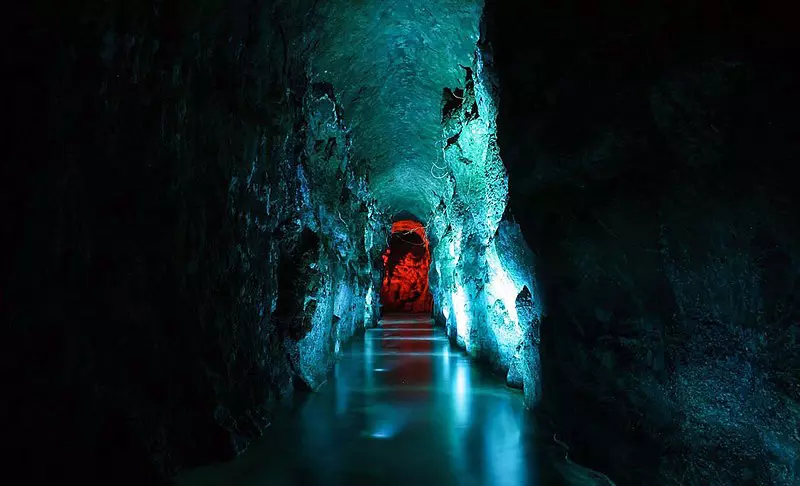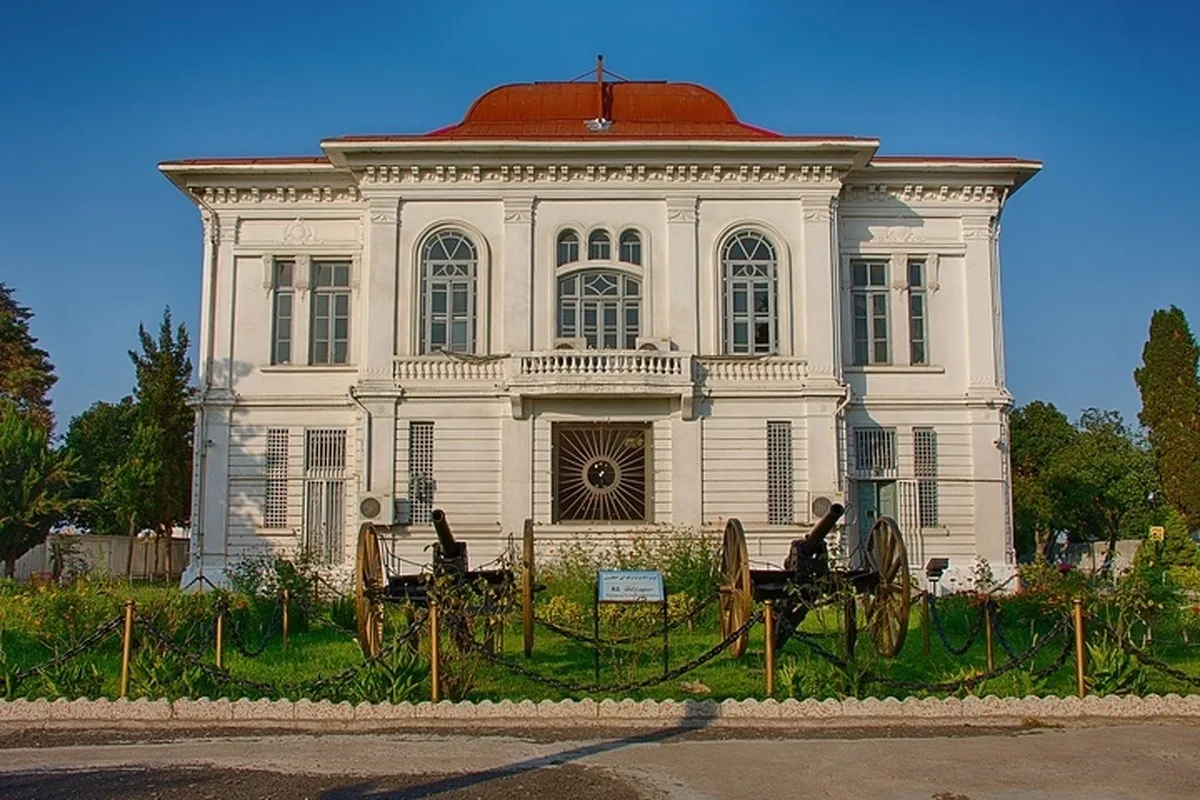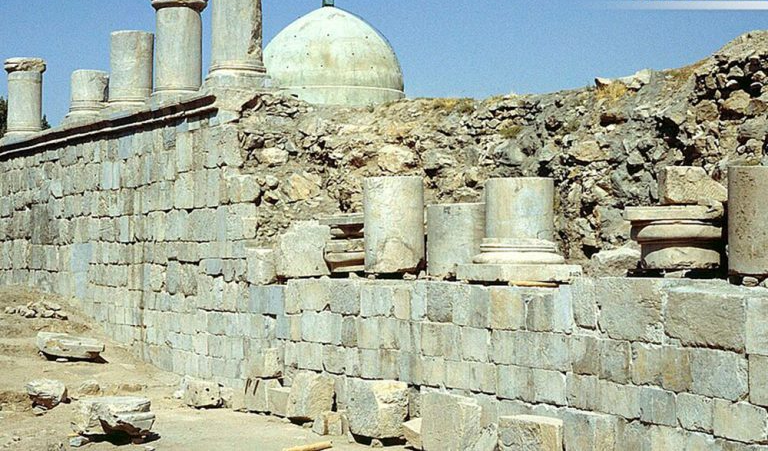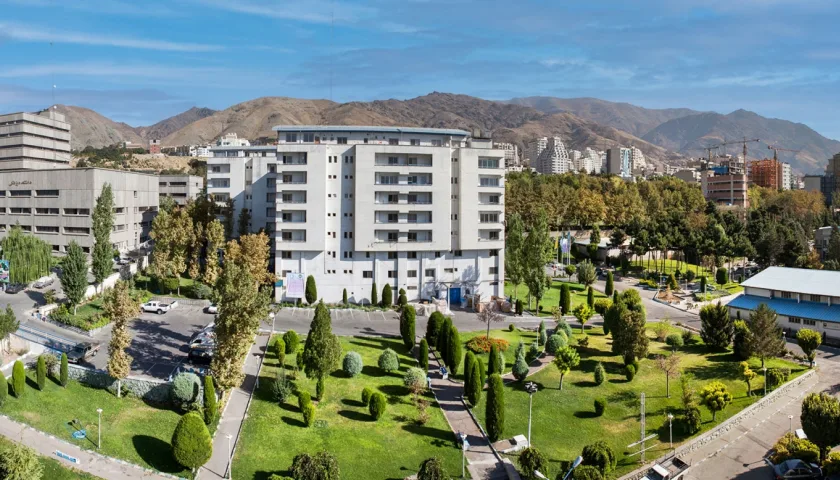In the Heart of Faith: Pilgrimage to The Shrine of Imam Reza ?
The Shrine of Imam Reza (AS) is one of the most famous tourist attractions in Mashhad and Iran. Millions of pilgrims from Iran and around the world visit the shrine annually to pay their respects to the eighth Imam of Shia Islam. The shrine has undergone numerous changes and developments throughout its history. Interestingly, historical accounts suggest that Imam Reza (AS) personally identified the location of his shrine during a journey to Merv.
In this article, we will delve into the history and introduction of various sections of the Imam Reza Shrine. Here is everything you need to know about the wonders of the Imam Reza Shrine:
1. How did Tus become the chosen burial place for Imam Reza (AS)?
2. Names of the Imam Reza Shrine.
3. Area and map of the Imam Reza Shrine.
4. Courtyards of the Imam Reza Shrine.
5. Dome and golden minarets of the Imam Reza Shrine.
6. Porticos of the Imam Reza Shrine.
7. Stones of the Imam Reza Shrine.
8. Exact burial location of Imam Reza (AS) in the shrine.
9. Graves of famous individuals in the shrine.
10. Mosques within the Imam Reza Shrine.
11. How many times has the Imam Reza Shrine been reconstructed?
12. Pilgrims and guests of Imam Reza (AS).
13. Other sections and facilities of the Imam Reza Shrine.
14. Photos of the Imam Reza Shrine.
15. Virtual and 3D pilgrimage of the Imam Reza Shrine.
16. Facts and wonders of the Imam Reza Shrine.
17. Live broadcast from the Imam Reza Shrine.
18. Dome and golden minarets of the Imam Reza Shrine.
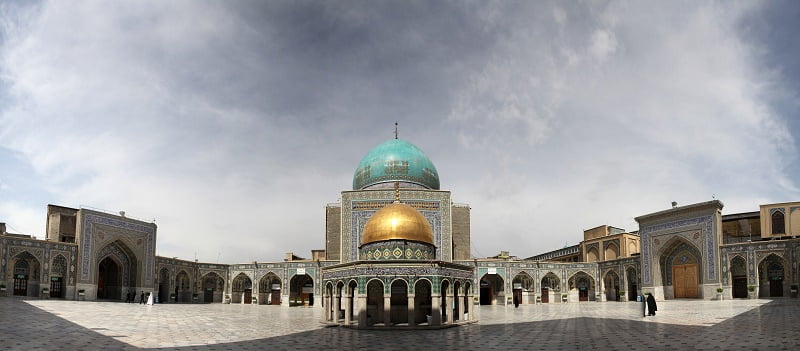
How Tus Became the Chosen Burial Place for Imam Reza (AS)
When Da’bal Khazai recited his famous ode praising the Ahl al-Bayt and describing their tragedies, he went to Tus to recite it for Imam Reza (AS). Upon reaching verses that mentioned sacred cities and the resting places of the pure, Imam Reza (AS) added two couplets with the same rhyme and meter:
“My grave in Tus will bear the burdens of calamities,
Afflictions will continuously enter its depths.
Until the Resurrection, when God will raise a Qa’im,
Who will relieve us from sorrows and distress.”
This meant that there would be a grave in Tus where calamities and grief would continually enter, causing perpetual anguish until the day when God sends a savior to relieve them. When asked whose grave it was, Imam Reza (AS) replied that it was his own and would remain so until Tus became a place frequented by Shia pilgrims and his devotees.
Before long, this prophecy came true. In the last days of the month of Safar in the year 203 AH, the compassionate member of the Ahl al-Bayt was martyred by the order of the Abbasid caliph and was buried in a small village called “Sanabad,” which was on the outskirts of Tus at the time. Twelve centuries later, this small village, thanks to the presence of the eighth shining star in the sky of Imamate and guardianship, expanded and, after overshadowing the city of Tus, is now a metropolis with an area of 351 square kilometers. It is considered the spiritual capital of Iran and annually welcomes over 25 million visitors and pilgrims from both inside and outside the country who come to pay their respects to the revered Imam.
Names of the Imam Reza Shrine
The sacred shrine of Imam Reza (AS) is among the most prominent attractions in Khorasan Razavi, known by various names and titles among the admirers and pilgrims of the revered Imam. Some of the names associated with the shrine include:
1. The Razavi Shrine: Highlighting the connection to Imam Reza (AS).
2. The Holy Shrine: Emphasizing the sanctity of the site.
3. The Sacred Land: Reflecting the revered nature of the area.
4. Radiant/Majestic/Most Pure Mausoleum: Describing the luminous and pure nature of the resting place.
5. Heart of the World: Symbolizing the central importance of the shrine.
6. The Heavenly Abode: Signifying a celestial dwelling.
7. Qiblah of Hopes: Referring to the focal point of aspirations.
8. The Custodian of Razavi Angels’ Abode: Associating with the angelic guardianship of the Imam.
9. The Noble Mausoleum: Highlighting the esteemed nature of the resting place.
It’s worth noting that the entire complex, including the holy shrine and its components such as libraries and museums, is referred to as the “Astan Quds Razavi.” Other names like “Razaviyah/Maqdese/Manoureh Sanctuary” are also commonly used in the media. The term “Rauzeh” originally means a garden or orchard and is used to denote the burial place of Imam Reza (AS) within the holy shrine. The term “Mazjeh Sharif” is another name for his revered resting place.

Total Area of the Imam Reza Shrine
The Imam Reza Shrine, also known as the Majestic Abode, stands as one of the grandest and most beloved places across Iran, extending beyond the spiritual realm. After the Islamic Revolution, significant attention was dedicated to its expansion. Apart from the ancient and modern courtyards, additional courtyards were constructed post-revolution, and eastern and western porches were added to the existing ones.
The total covered pilgrimage space of the entire complex, considering all religious and non-religious sections, surpasses one million square meters, with a capacity for accommodating 700,000 individuals. The Astan Quds Razavi was registered as a national monument with the number 140 on January 15, 1310 (solar calendar). This remarkable site, with its historical, artistic, and architectural values in addition to its spiritual significance, has become a comprehensive global complex that captivates the hearts of many.
Courtyards of Imam Reza Shrine
Upon entering the Imam Reza Shrine, pilgrims find themselves in one of the nine courtyards, each with its unique significance and name. These courtyards are:
- 1. Islamic Revolution Courtyard (Ancient or Old Courtyard): Also known as the Ancient Courtyard, it is the oldest and occupies the northern side of the shrine with an area of 6,740 square meters. It was initially built during the Timurid era and expanded during the Safavid period.
- 2. Freedom Courtyard (New Courtyard):After the Islamic Revolution, this courtyard, with an area of 4,340 square meters, was renamed Freedom Courtyard. It is one of the largest courtyards in the Imam Reza Shrine and is located on the eastern side, connecting to the Manoureh Mausoleum.
- 3. Islamic Republic Courtyard: Positioned on the northern side of the shrine, this courtyard has its own historical and architectural significance.
- 4. Holy Courtyard: Known as the Qods Courtyard, it holds a special place within the shrine.
- 5. Jameh Razavi Courtyard: This is the central and comprehensive courtyard of the Imam Reza Shrine.
- 6. Ghadir Courtyard: Named after the Ghadir event, it holds a particular historical context.
- 7. Kosar Courtyard: Reflecting the sacredness of the location, this courtyard has its unique importance.
- 8. Hidayat Courtyard: Symbolizing guidance, this courtyard is an integral part of the shrine.
- 9. B’athat Courtyard: This courtyard is associated with the mission of the Prophet Muhammad (PBUH).
It’s essential to distinguish between “Bast” and “Sahn.” Sahns are the vast courtyards of the shrine, while “Bast” refers to a section of the holy shrine that used to be restricted, preventing foreigners and non-Muslims from passing through. In the past, these bast areas were where dignitaries were received, and people sought refuge from oppression or engaged in protest. Although the practice of “Bast Neshini” has diminished, the name still lingers on certain parts of the shrine.
Islamic Revolution Courtyard (Ancient Courtyard)
The Islamic Revolution Courtyard, also known as the Ancient Courtyard, is the oldest section of the shrine, covering 6,740 square meters on its northern side. It wasn’t constructed all at once; rather, half of it was built during the Timurid era, and the other half was expanded during the Safavid period. The southern part of this courtyard includes the historic Naderi Ivan, also known as the Naderi Golden Ivan, constructed during the Timurid era.
The Ivan Abbasi, located on the northern side, is connected to the Tabarsi Gate. The architecture of this Ivan is a masterpiece of tilework and inscriptions, with verses from the Quran and Friday Surah beautifully displayed. The Ivan also houses the tomb of Amir Ali-Shir Navai, the Timurid-era scholar and minister who initiated the construction of this courtyard.
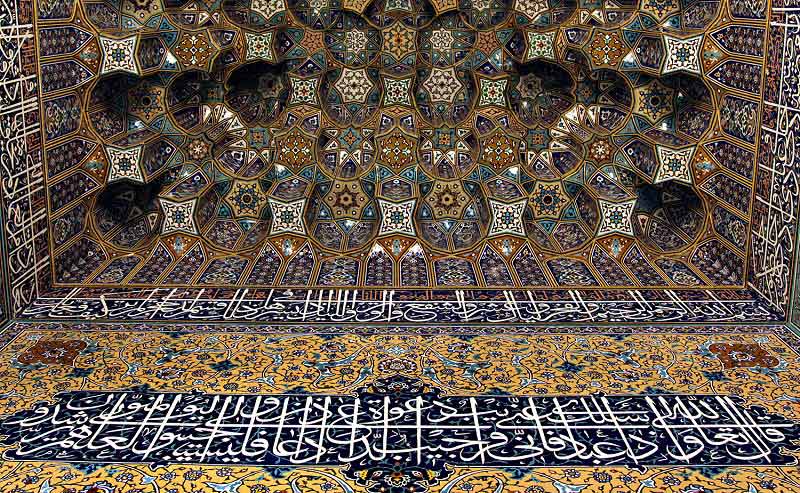
Notably:
– The Golden Ivan (Ivan Naderi): The southern Ivan, known for its exceptional architecture and connection to Nader Shah Afshar, who adorned it with gold, hence the name Naderi.
– Abbasid Ivan (Ivan Abbasi): Located on the northern side and connected to the Tabarsi Gate, it is renowned for its exquisite tilework and inscriptions.
The Ivan Clock in the western part is also significant, and the second floor of the eastern Ivan houses the Nagharekhaneh (drum house), where traditional drumming has been performed since the Safavid era, particularly during sunrise, sunset, and special occasions.
Freedom Courtyard
Previously referred to as New Courtyard, it was renamed Freedom Courtyard after the Islamic Revolution. Covering an area of 4,340 square meters, it is one of the largest courtyards in the Imam Reza Shrine. Situated on the eastern side, it connects to the Manoureh Mausoleum, providing a distinct atmosphere and architectural features. In this courtyard, a large basin replaced the previous Saghakhaneh (water distribution area), which was removed to prevent crowding between pilgrims and the golden Ivan during greetings and respect rituals. This modification occurred in 1271 according to the Qajar era.
New courtyards of the shrine are as follows:
Nasiri Golden Courtyard:
Located on the western side of the courtyard, Nasiri Golden Courtyard is the most prominent section that captivates the attention of pilgrims upon entry. Connected to the Hall of Bliss through a small passageway adorned with golden doors on both sides, it is named Nasiri as it was adorned with gold during the era of Naser al-Din Shah. This courtyard is dedicated to women.
Clock Courtyard or Southern Courtyard:
This courtyard stands out due to the clock installed on it. The clock, a gift from Mozaffar al-Din Shah, was initially placed in the Enqelab Courtyard. The sound of this clock, audible in various parts of the city during the less developed years of Mashhad, echoes in the southern courtyard.
Eastern Courtyard of Azadi (Freedom) Courtyard:
Known as Bab al-Salam, this courtyard has undergone several reconstructions, especially the northern part, during the Pahlavi era. It is also known as the Telegraph Courtyard.
Paradise of the Eighth Imams (Imam Reza’s Shrine No. 1):
Situated beneath this courtyard, accessible from the northeastern and southeastern sides, it serves as the resting place for the martyrs of the eight-year defense and the custodians of the Razavi shrine.
Imam Khomeini Courtyard (Imam Reza’s Shrine No. 3):
Considered the third courtyard in terms of historical significance, it initially housed antiquated shops named “Teimcheh Paein-Pa” and a semi-ruined school named “Saad al-Din’s School.” Following its inauguration in 1324, it initially served ceremonial and hosting purposes for the country’s leaders. The courtyard, with two ivans to its west and north, underwent changes after the revolution, including the removal of the southern fence and the construction of a wall. Originally intended for a museum and library, the structures were demolished in 1353 to expand the courtyard to 10,000 square meters. In 1381, due to the increasing number of pilgrims, a significant part of the courtyard was repurposed, covered, and named the Imam Khomeini Portico. The smaller part is now called the B’athat Portico.
Reza’s Comprehensive Courtyard:
Reza’s Comprehensive Courtyard, with a length of 363 meters, a width of 167 meters, and a total area of 117,584 square meters, is the largest courtyard in Imam Reza’s shrine. Various ceremonies, including speeches by the Supreme Leader at the beginning of each solar year and gatherings of Hussein’s mourners during the month of Muharram, take place in this courtyard. Inaugurated in 1381, it can accommodate 70,000 worshipers. Its three ivans are named Vali Asr on the southern side, Bab al-Kawthar on the eastern side, and Bab al-Ghadir on the western side, each adorned with two elevated minarets.
Islamic Republic Courtyard:
Located on the western side of the holy shrine, this courtyard was inaugurated in 1368 to expand the shrine’s area to 7,292 square meters. Resembling the Enqelab Courtyard, it features two golden-adorned ivans, a goldsmith ivan, a water reservoir, and a window for reading Ziyaratnama from a distance. The only difference is that the window in the Islamic Republic Courtyard is made of bronze. The Paradise of the Eighth Imams No. 3, where the martyrs of the Ashura explosion of 73 are buried, is also situated beneath this courtyard.
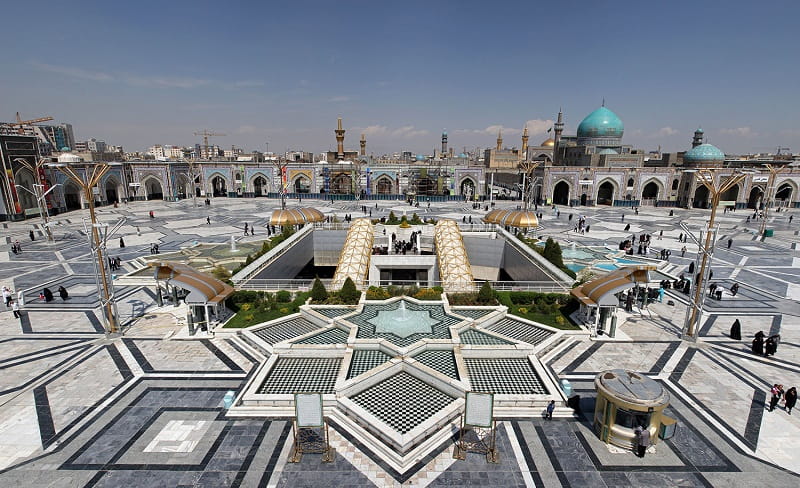
Quds Courtyard:
With an area of approximately 2,530 square meters, Quds Courtyard is the smallest courtyard in Imam Reza’s shrine. Established in 1373 among the Goharshad Mosque, Imam Khomeini’s Museum Courtyard, Shaykh Bahai’s Complex, and Reza’s Comprehensive Courtyard, its water reservoir is designed in the size of an eighth of the actual dome of the Rock. Additionally, the Paradise of the Eighth Imams No. 2 is located beneath this courtyard.
Hedayat Courtyard:
A newly established small courtyard with an area of 17,980 square meters, Hedayat Courtyard is located on the northeastern side of the holy shrine. It houses the Islamic Research Foundation, Razavi Islamic Sciences University, and the Guesthouse of Hazrat.
Ghadir Courtyard:
With an area of 14,453 square meters, Ghadir Courtyard is situated in the southwest of the holy shrine. Through this courtyard, access is provided to the Ghadir Commercial Services Complex, which includes foreign health services. The sermon of Ghadir and the blessed name of Ali ibn Abi Talib (peace be upon him) can be observed on all tiles and inscriptions.
Kowsar Courtyard:
Covering an area of about 15,648 square meters, Kowsar Courtyard is located in the northeast of the holy shrine, between the Comprehensive Courtyard, Imam Khomeini’s Portico, and the Azadi Courtyard. All tiles in this courtyard are adorned with the blessed name of the Lady of the Two Worlds, and the sermon of Fadak is inscribed on its inscriptions.
The golden dome and the minarets of the Holy Shrine of Imam Reza (AS)
The golden dome of the Holy Shrine of Imam Reza (AS) is a magnificent display of art and religious significance, capturing the hearts of countless admirers. Comprising an inner dome called “Khoda” and an outer dome known as “Ahiyaneh,” the inner dome is the roof of the blessed mausoleum, also referred to as the “Qibla,” visible from within the sanctuary.
The first dome built above the resting place of Imam Reza’s father was constructed during the Seljuk period. Some consider domes to symbolize the head of a human, with the minarets representing uplifted hands in supplication towards the divine throne. Others view them as pointers toward the Qibla. Beyond their spiritual significance, these architectural elements hold historical importance.
Golden Dome of the Holy Shrine of Imam Reza (AS)
The first dome atop Imam Reza’s (AS) shrine was built during the Seljuk era, approximately a thousand years ago. Legend has it that this dome, known as the Haruniyyah Dome, was initially constructed by Ma’mun for his father and later served as the final resting place for Imam Ali al-Ridha (AS). Another account attributes the building of this shrine and its dome to an existing structure in the Hamid ibn Qahtaba garden, which Ma’mun later repurposed for the burial of his father and then, ten years later, for Imam Ali al-Ridha (AS). Unfortunately, this dome was destroyed during the events in the fourth century in Khorasan, and Sultan Mahmud Ghaznavi undertook its reconstruction, adding a new dome to the mausoleum.
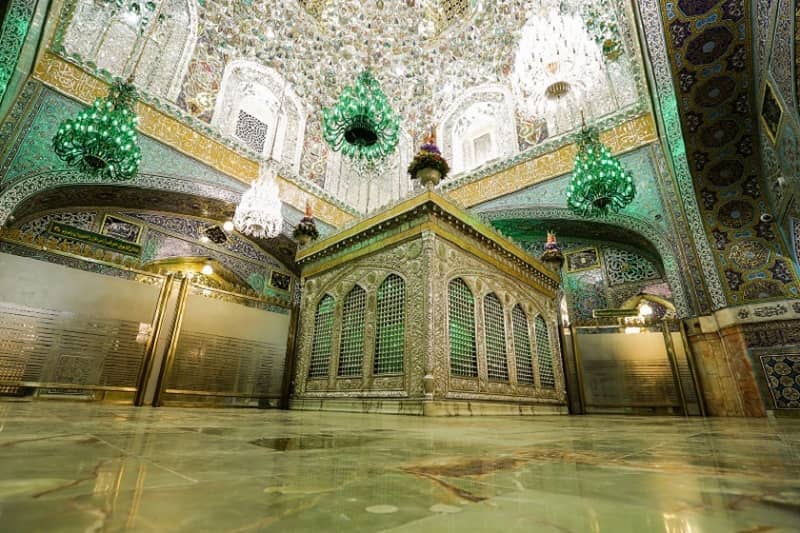
The golden dome underwent various renovations and repairs over the centuries. It was adorned with gold during the reign of Shah Tahmasp Safavi, suffered looting by the Uzbeks, and was subsequently repaired and gilded by Shah Abbas. In 1084 Hijri, a devastating earthquake struck Mashhad, severely damaging the dome. Sultan Solaiman Safavi took the initiative to restore and reinforce the dome, and during the Pahlavi era, it underwent further repairs. In 1358, the worn-out tiles were replaced with gold-covered copper sheets using an electroplating process.
Minarets of the Holy Shrine of Imam Reza (AS)
The Holy Shrine boasts 12 minarets, with two towering minarets standing at 41 meters located in the Goharshad Mosque. Additionally, there are two gold-covered minarets measuring 40.5 meters in the Enqelab courtyard, two 35-meter minarets adorned with tiles and gold coating in the Jomhouri courtyard, and four 57-meter minarets in the eastern and western sides of the Razavi courtyard. Two more minarets, standing at 70 meters, grace the Qibla side of the Jomhouri courtyard.
Among all the minarets, two stand out – those in the Enqelab courtyard. Their strategic design by the architect Nader Shah Naderi creates an optical illusion for pilgrims entering from Imam Reza Street, making it appear as though the dome is perfectly centered between the two minarets.
Arcades of the Holy Shrine of Imam Reza (AS)
The arcades within the Holy Shrine, much like its courtyards and iwans, exemplify valuable works of art from various historical periods. There are 27 arcades, each serving a specific purpose, including Dar al-Hifaz, Dar al-Siyadah, Gohar Khani Dome Arcade, Dar al-Servants, Dar al-Fayd, Dar al-Shukr, Dar al-Sharaf, Dar al-Da’wah, Dar al-Sa’adah, Dar al-Ziyafah, Dar al-Salam, Dar al-Sarwar, Dar al-Suroor, Dar al-Shafaqah, Dar al-Zikr, Dar al-Zuhd, Sheikh Baha’i Arcade, Dar al-Adab, Dar al-Salat, Dar al-Rahmah, Dar al-Hikmah, Dar al-Zafr, Dar al-Hujjah, Dar al-Quran, Hazrat Ma’sumah (SA) and Hazrat Zahra (SA), and two private arcades named Sheikh Har Ameli and Sheikh Tusi.
Each arcade serves a distinct purpose, with Dar al-Tawhid Arcade, located amidst the steel windows from the north and the holy shrine’s shrine in the south, being of particular significance. Dar al-Ajabah Arcade, situated in the basement of the shrine, is the closest location to the revered resting place of Imam Ali al-Ridha (AS). It features an octagonal space with a silver window and a half-dome that leads to the holy shrine’s basement.
Family arcades include Dar al-Zuhd, Dar al-Ibadah, Sheikh Baha’i, Dar al-Wilayah, Dar al-Hidayah, Dar al-Rahmah, Dar al-Ijabah, Dar al-Hujjah, Kowsar, Ghadir, Sheikh Tusi, Dar al-Murahamah, Sheikh Har Ameli, and Imam Khomeini (RA) Arcade. Dar al-Karamah Arcade is dedicated to the servants of the shrine.
These arcades showcase the rich architectural and historical heritage of the Holy Shrine of Imam Reza (AS), providing spaces for various religious, political, and social activities.
Please note that this translation is a general summary, and specific details or nuances from the original text may not be fully captured.
History of the Construction of Imam Reza’s Shrine
To reach the illuminated sanctuary, one must pass through the Safa areas. The space situated right under the dome of Razavi and housing the holy shrine of Agha Ali ibn Musa al-Reza (AS) is referred to as the illuminated sanctuary. The illuminated sanctuary is a four-sided space with an area of 189.03 square meters, 17.15 meters of which is allocated to the holy shrine. Access to the sanctuary is provided from all four sides through the Safa areas: the southern Safa, the eastern Safa, the northern Safa (named after Shah Tahmasb since he is buried there, known as Shah Tahmasbi), and the western Safa or the upper area above the head of the Imam, which marks the boundary between the sanctuary and the upper mosque.
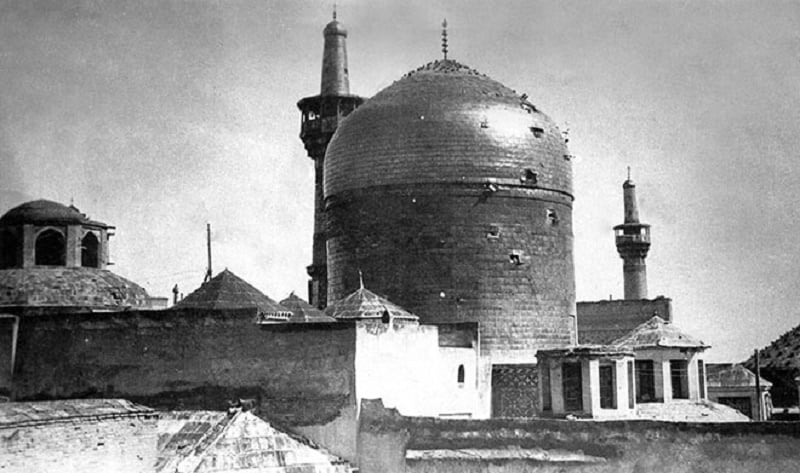
Imam Reza’s Shrine
The current shrine of Imam Reza (AS) has dimensions of 3 by 4 meters and weighs 12 tons. The Surahs “Yaseen” and “Hal Ata” are inscribed on it in a way that each of the four corners of the shrine concludes with the blessed word “Allah.” The design of the shrine also incorporates an aspect related to one of the titles of the eighth Imam (AS), namely “Shams al-Shamseen,” and sunflowers symbolizing the sun are used. The current design of the shrine was executed by Master Mahmoud Farshchian. Interestingly, this design was selected through a competition among artists. This shrine, installed in its current location in 1379, is not the first shrine of Imam Reza (AS) but the fifth.
Before installing the first shrine on the sacred tomb of Imam Reza (AS), in addition to the tombstone, a box was also placed on it. The first box, made of wood, was placed on the Imam’s tomb by an individual who converted to Islam due to a miracle in 500 Hijri. This wooden box had a cover of silver. The second box, also wooden but with a gold cover, was installed on the sacred tomb in 1022 Hijri. However, the third box was made of marble and was installed in 1311 Hijri, until it was eventually replaced by a wooden shrine.
The first shrine was made of wood with decorations of gold and silver, and it was installed on the tomb in the Seljuk era. This wooden shrine, known as the “Negin Neshan” shrine, was dedicated to the holy shrine during the Qajar period. This shrine was used until 1379, and it is now preserved in the central museum of Astan Quds Razavi. The second shrine is known as the “Lion and Sugar” shrine, donated to Astan Quds by Nader Shah’s grandson. It was in use until 1379 and was installed inside the fourth shrine. After removing the fourth shrine, this shrine was also transferred to the basement and installed on the sacred tomb.
The third shrine of the holy shrine was a steel structure with a vaulted roof and a golden ring. It was built during the Qajar period and gave way to the fourth shrine in 1338, now preserved in the museum. The fourth shrine, known as the “Lion and Sugar” or the “Gold and Silver” shrine, had 14 alcoves representing the 14 infallibles, with each alcove adorned with the name of one of the infallibles. This shrine weighed seven tons. After 41 years, it gave way to the new museum and was transferred to the central museum of Astan Quds.
The fifth shrine, designed by Master Farshchian, involved collaboration from prominent artists in various fields. Engraving, calligraphy, and illumination were handled by Master Keshti Arayi Shirazi, Master Khoddadzadeh Isfahani, and Master Mohtadi, respectively. The construction of the fifth shrine took seven years and was inaugurated on the 16th of Esfand in 1379, concurrently with the auspicious occasion of Eid al-Qurban, in the presence of the Supreme Leader (may his exalted shadow endure).
Imam Reza’s Gravestone
From the beginning to the present day, three types of stones have been installed on the sacred soil of Shah Khorasan. Each stone, after being replaced, has been transferred to the museum of Astan Quds. The first stone of Agha Ali ibn Musa al-Reza (AS), known as the previous stone, was installed on the tomb during the Seljuk period. The previous stone, made of marble, had dimensions of 40 by 30 and a diameter of 6 centimeters. The oldest stone of Imam Reza (AS) is now preserved in the museum of Astan Quds. This stone was on the sacred tomb of the eighth Imam (AS) until the Safavid era when it was replaced by the new gold-covered stone.
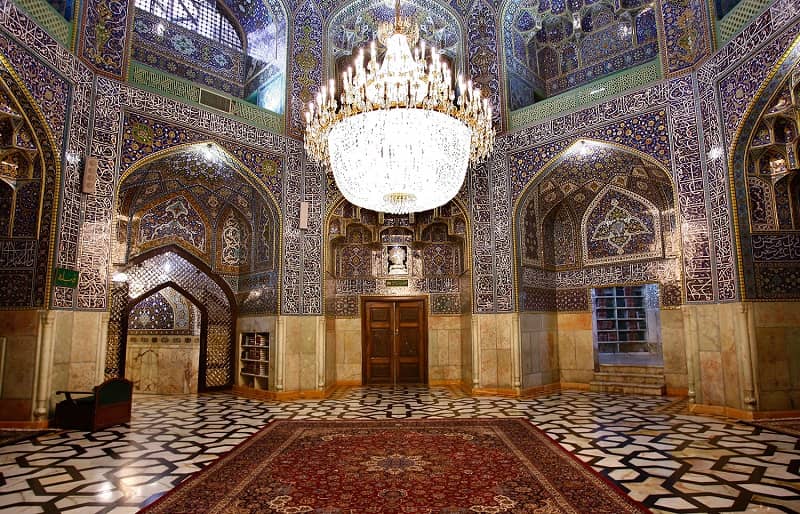
Goharshad Mosque:
Goharshad Mosque, located in the middle of the Illuminated Garden and the portico of Dar al-Siyadah, is one of the significant mosques within the sacred complex of Imam Reza’s shrine. The mosque includes two historical and culturally important places, Goharshad Mosque and Balasar Mosque.
Goharshad Mosque, also known as the Goharshad Shrine, was built in the 9th century AH by the order of Banu Goharshad, the wife of Mirza Shahrokhtimur, during the Timurid era. It is considered a masterpiece of Iranian art and architecture from the Timurid period. This mosque, with a total area of 2855 square meters, four porches, and seven prayer halls, is situated in the southern part of the holy shrine of Imam Reza. Its construction took 12 years, and it is sometimes considered one of the courtyards of the holy shrine, with some regarding it as the oldest courtyard of the shrine.
Goharshad Mosque is a remarkable piece of world architecture. The building features four porches and is adorned with exquisite tiles, calligraphy, stucco work, and intricate patterns on its walls. The mosque has undergone renovations twice, once after the earthquake of 1084 AH, which caused significant damage, and later after the Russian invasion in 1330 AH.
The southern porch of Goharshad Mosque is particularly striking, adorned with precious tiles inscribed with Quranic verses and hadiths. The historical inscription by Baysonqor, Goharshad’s son, a prominent calligrapher of the Timurid era, is visible on the left side of the southern porch. The mihrab and pulpit of the southern porch are made of a single piece of carved marble and wood, respectively. The pulpit, crafted by the renowned artist of the Qajar era, remains a testament to both historical and artistic value.
Balasar Mosque:
Balasar Mosque, also known as the Thousand-Year-Old Mosque, is situated above the shrine of Imam Reza, between the Illuminated Garden and the portico of Dar al-Siyadah. Despite its small size, this mosque, dating back to the Ghaznavid period, holds great significance. It is the first building constructed after the Illuminated Garden. According to Bayhaqi, this mosque is mentioned in historical records.
Measuring only 8 meters in length, 4.5 meters in width, and 10 meters in height, Balasar Mosque is adorned with hexagonal tiles featuring Quranic verses and hadiths. Two valuable inscriptions are installed above the marble dome, facing the holy shrine. One of these inscriptions contains two verses by Da’bal Khazai, emphasizing the proximity of the burial places of Imam Ali ibn Musa al-Reza and Harun al-Rashid, highlighting the lesson that impurity does not benefit from the proximity of purity.
History of Reconstruction of Imam Reza’s Shrine:
Imam Reza’s shrine has undergone multiple reconstruction efforts throughout its 1200-year history. The initial structure was a simple mausoleum with a dome, constructed during the Samanid period. Over time, various sections were rebuilt and new additions were made, transforming the complex into one of the world’s largest religious sites, accommodating over 700,000 pilgrims.
The first construction around the sacred burial site occurred during the Samanid era. Subsequent rebuilding took place during the Dailamites’ rule when the mausoleum was rebuilt after being demolished by Sultan Mahmud Ghaznavi. During the Safavid era, Mashhad was twice invaded by the Uzbeks, resulting in significant destruction. Shah Abbas I personally led the reconstruction efforts, expanding the courtyard, constructing the northern porch and eastern and western porticos, and adding Tawhidkhaneh portico and Gonbad-e-Allavardi-Khan.
Notable Events in the Shrine’s History:
- 1. Destruction by Mahmud Ghaznavi: During the 4th century AH, Mahmud Ghaznavi ordered the destruction of the eighth Imam’s shrine. Despite being reconstructed by his son, it marked a dark period in the history of the shrine.
- 2. Uzbek Invasions: In the Safavid era, Mashhad was twice invaded by Uzbek forces. The first invasion by Abdullah Khan resulted in a massacre, and the second by Abdul-Mumin Khan led to further destruction and pillaging. Shah Abbas I personally undertook the reconstruction, expanding the shrine complex.
- 3. Contemporary Renovations: Ongoing efforts for preservation and renovations have continued in the modern era. Notable projects include the construction of the Republic Square in the holy shrine.

The history of Imam Reza’s shrine is rich with events, invasions, and reconstructions, making it a symbol of resilience and devotion for millions of pilgrims worldwide.
Mashhad has experienced numerous earthquakes; however, the most significant and destructive one was the earthquake of 15 Rabi’ al-Thani 1084 AH, which destroyed two-thirds of Mashhad and claimed the lives of 4,000 people. The holy mausoleum of Imam Reza (AS), the dome of Goharshad Mosque, and the Prizad, Dowdar, Balasar, and Payin-Pa schools were not spared from damage and suffered extensive losses. They were reconstructed during the reign of Shah Suleiman Safavi.
The holy shrine faced looting twice during the Qajar period. The first time was in 1263 AH when Mohammad Hasan Khan Salar Farzandullah, the son of Allahyar Khan Asif al-Dawlah, declared independence. He collected all the gold from the shrine, minted coins in his name, and the second time was in Muharram 1330 AH when the shrine was closed off with cannons by the Russians. In this incident, Russian soldiers shot the people who had gathered in opposition to the turmoil of the constitutionalists in the sanctuary. The golden dome of the shrine was hit in 18 places, and after two hours of bombardment, the Russian forces, both cavalry and infantry, entered the sacred precinct and fired upon the people until finally, the custodian of Astan Quds Razavi raised a white flag, seeking refuge from the Russians. During the four days, the Russians looted treasures and valuables from the shrine. Sultan Hussein Mirza Nir al-Dawlah, the governor of Khorasan in 1331 AH, renovated the shrine. Some of the bullets in the golden portico of the ancient sanctuary are still preserved.
Another unfortunate event was the Goharshad Mosque incident, which occurred by the order of Reza Khan. This event took place in 1314, following the people’s protest against the unveiling law and their gathering in Goharshad. In July 1314, government troops opened fire on the people who had gathered in Goharshad, resulting in the death and injury of many.
In another event on the 29th of Aban, 1357, armed forces of the Pahlavi regime entered the revolutionary sanctuary and shot the protesting people.
Another incident occurred on the 30th of Khordad, 1373, coinciding with the day of Ashura. On this day, mourners and various groups of Hussaini mourners were reciting elegies and mourning in the sacred sanctuary of Razavi when a horrifying sound erupted at 2:26 p.m. An intense bomb placed next to the blessed high column near the holy tomb exploded. The explosion was so powerful that windows shattered, and 27 pilgrims were martyred. This event also left 290 injured.
According to the announcement of the custodian of Astan Quds Razavi, the holy shrine annually hosts 30 million Iranian and non-Iranian pilgrims. Iraqis constitute the largest number among non-Iranian pilgrims, and their numbers are significant enough for one of the arcades of the shrine to be allocated for special programs for them.

On special occasions, the number of pilgrims to the holy shrine of Razavi increases by another 20 to 25 percent. For the accommodation of pilgrims, in addition to hotels and private accommodations, Astan Quds Razavi has prepared facilities. The Razavi Pilgrim Complex with six residential blocks, including a restaurant and a mosque with a capacity of 600 people, as well as three hostels, is engaged in hosting pilgrims on a 35-hectare site at the beginning of the city of Torghab. Another complex is also active at the end of Chaman Boulevard. Another pilgrim city and another pilgrim lodge are also under construction by Astan Quds Razavi, two kilometers away from the shrine.
The guesthouse of Hazrat in the northern side of Sheikh Har Ameli Street and Gadir Square accommodates pilgrims and even its neighbors. At noon, this square is filled with pilgrims who have lined up for the blessing of Hazrat’s food. The history of this guesthouse dates back to the Safavid era when it was known as the Mamarah Kitchen. It had various sections, and its duty was to prepare food for the needy neighbors and pilgrims who came to visit that Imam.
Other Sections and Facilities of Imam Reza (AS) Holy Shrine
Museums:
1. Central Museum: The central museum of the holy shrine of Imam Reza (AS) is a four-story complex showcasing a vast collection of valuable and diverse artifacts. The stamp and banknote treasury are located on the lower floor, the Mashhad history treasury and coin and medal treasury on the ground floor, the shell, snail, and marine soft-bodied treasury, and the visual arts treasury on the first floor, and the astronomy and clock, weapons, and utensils treasury on the second floor of the museum. This museum is accessible from the Koosar courtyard.
2. Valuables Treasury Museum: This museum, located on two floors in the southeast corner of the holy shrine, includes a Quran treasury on its first floor. Currently, it displays 79 precious Qurans, including works attributed to Imam Ali, Imam Hasan Mojtaba, Imam Hussein, Imam Zain al-Abidin, and Imam Reza (peace be upon them). It also houses gifts from the esteemed leadership and gifts from Master Mahmoud Farshchian. This treasury is accessible from the Koosar courtyard.
3. Carpet Museum: The first specialized carpet and textile treasury initially operated in the building of the Quran and valuables treasury and later transferred to its current location in 1390. Approximately 100 precious carpets and rugs with historical and artistic value, some dating back to the Safavid era, are displayed in this museum.
4. Anthropology Museum: The anthropology museum is located next to the burial place of Amir Molk Shah in the southwest corner of the holy shrine. Originally a bathhouse, it was endowed to the shrine during the reign of Shah Abbas Safavi and repurposed as a museum after reconstruction in 1385. In addition to the exhibited objects, the bathhouse building itself holds significant value. This museum is accessible through the Jameh courtyard.
Other Facilities:
1. Quran Attributed to Imam Reza (AS): A Quran attributed to Imam Ali ibn Musa al-Reza (AS) is on display in the Treasury of Valuables; source: the portal of the Holy Shrine of Imam Reza (AS).
2. Islamic Research Foundation
3. Rezavi Islamic Sciences University
4. Dar al-Shafa, Imam Reza’s (AS) Health Center, located in the southern quarter near the Shiraazi Street (Sheikh Toosi entrance), is equipped with complete medical facilities, including an emergency room, radiology, laboratory, 24/7 pharmacy, and specialized clinics.
5. Central Library of Astan Quds Razavi: This library is considered one of the wonders of the Imam Reza (AS) shrine, with over 7 million visitors, making it one of the most active libraries in Iran. Some of the books and documents preserved in this library date back to the 12th century. The library is located in the northern side of Sheikh Toosi courtyard.
6. Library of Goharshad Mosque: Established in 1332, this library is adjacent to Goharshad Mosque. It covers an area of 1200 square meters in the Sheikh Bahai courtyard and is recognized as a specialized library for the Ahl al-Bayt (AS), serving as an important center for the dissemination of Islamic culture.
7. Cemeteries named Paradise of the Eighth Imams 1, 2, and 3
8. Electric wheelchairs are available at the entrances of Bab al-Jawad and Bab al-Reza for the convenience of the elderly, children, patients, and individuals with mobility issues. Additionally, wheelchair stations operate 24/7 at most entrances of the holy shrine.
9. Parking lots around the shrine
10. Health services and ablution facilities located at various entrances of the shrine
11. Exhibition and conference center of Astan Quds Razavi at the entrance of Bab al-Jawad
12. Exhibitions and bookstores offering cultural products at the entrances of Bab al-Jawad, Sheikh Har Ameli, Sheikh Tabarsi, and Sheikh Toosi. In these stores, visitors can purchase cultural products and items such as the turquoise of the shrine of Imam Reza (AS).
These facilities and amenities contribute to providing comprehensive services to pilgrims and visitors of the holy shrine of Imam Reza (AS).



